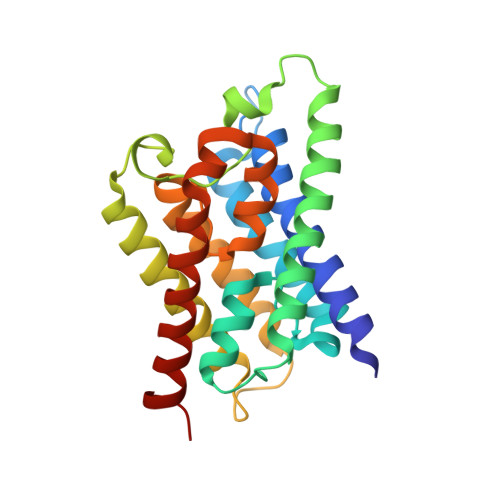Structural context shapes the aquaporin selectivity filter.
Savage, D.F., O'Connell, J.D., Miercke, L.J., Finer-Moore, J., Stroud, R.M.(2010) Proc Natl Acad Sci U S A 107: 17164-17169
- PubMed: 20855585
- DOI: https://doi.org/10.1073/pnas.1009864107
- Primary Citation of Related Structures:
3NK5, 3NKA, 3NKC - PubMed Abstract:
Aquaporins are transmembrane channels that facilitate the permeation of water and small, uncharged amphipathic molecules across cellular membranes. One distinct aquaporin subfamily contains pure water channels, whereas a second subfamily contains channels that conduct small alditols such as glycerol, in addition to water. Distinction between these substrates is central to aquaporin function, though the contributions of protein structural motifs required for selectivity are not yet fully characterized. To address this question, we sequentially engineered three signature amino acids of the glycerol-conducting subfamily into the Escherichia coli water channel aquaporin Z (AqpZ). Functional analysis of these mutant channels showed a decrease in water permeability but not the expected increase in glycerol conduction. Using X-ray crystallography, we determined the atomic resolution structures of the mutant channels. The structures revealed a channel surprisingly similar in size to the wild-type AqpZ pore. Comparison with measured rates of transport showed that, as the size of the selectivity filter region of the channel approaches that of water, channel hydrophilicity dominated water conduction energetics. In contrast, the major determinant of selectivity for larger amphipathic molecules such as glycerol was channel cross-section size. Finally, we find that, although the selectivity filter region is indeed central to substrate transport, other structural elements that do not directly interact with the substrates, such as the loop connecting helices M6 and M7, and the C loop between helices C4 and C5, play an essential role in facilitating selectivity.
- Graduate Group in Biophysics, Department of Biochemistry and Biophysics, University of California, San Francisco, CA 94158-2517, USA.
Organizational Affiliation:

















